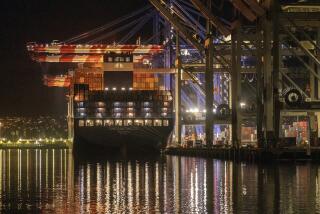Ashby Harper was “extremely disappointed” as he...
- Share via
Ashby Harper was “extremely disappointed” as he climbed out of the water Tuesday morning after swimming only about halfway from Santa Catalina Island to the Palos Verdes Peninsula.
Harper, who will be 72 on Oct. 1, was trying to become the oldest person to make the 19-mile swim, but gave it up after nearly seven hours because of nausea and an old shoulder injury. He was taken aboard the accompanying 42-foot yacht Golden Greek at 5:45 a.m.
Harper, a retired Albuquerque, N.M., private school administrator who has pulled off one or more long-distance swims a year for the past eight, thinks he may have tried to do too much lately. On July 31, he swam 28 miles around Manhattan Island and on Aug. 20 made it halfway across the 21-mile English Channel, a waterway he got clear across in 1982. He is the oldest person to make both swims.
“I did Manhattan in 1983 in nine hours and this time in eight and a half,” he said. “So I was confident about this.”
It wasn’t the San Pedro Channel that did him in, he said, adding, “I’d love to go back home and say the elements exceeded me, but the channel was about as smooth as it ever gets and the water was 68 degrees. I can’t complain on that score.”
Bobby Nganjimirra and Thompson Yulijirri are in town. They are said to be two of the last living aboriginal cave (rock) painters from Australia. They showed up at the CAZ Gallery in West Hollywood on Tuesday with Colin Dixon, an aboriginal dot-and-circle painter, to call attention to an exhibit opening tonight.
With them was Dorothy Bennett, 76, who has spent 30 years working with the people in Arnhem Land, a 31,000-square-mile aboriginal reserve in Australia’s Northern Territory. She is worried because the traditional art of bark painting is dying out as young men acquire Western educations and lose interest in following the ways of their fathers.
A couple of the artists played the didgeridoo, which you probably won’t find featured by any local groups. It is a hollowed-out log. “There are very few didgeridoo players,” Bennett said. “It is very strenuous and a lot of the old men have respiratory problems.”
Also present was Neil Murray, a 32-year-old Australian musician who organized the first aboriginal rock group, the Warumpi Band.
It’s about time, Supervisor Kenneth Hahn thinks, that the statue of Stephen M. White is moved from outside the County Courthouse. White, after all, was the father of the Los Angeles Harbor. San Pedro is about to celebrate its 100th birthday.
“What could be more fitting,” Hahn asks in the motion he will present to his fellow supervisors next week, “than to commemorate this event with the relocation of the statue of the late Sen. Stephen M. White to the city of San Pedro?”
(San Pedro, of course, is no longer a city. It became part of Los Angeles nearly 80 years ago.)
Hahn notes that White was instrumental in establishing the harbor at San Pedro despite “powerful interests, led by railroad baron Collis Huntington,” who wanted it at Santa Monica.
For 50 years, White’s statue was outside the old County Courthouse at Broadway and Temple Street. In 1958, it was placed outside the new County Courthouse at Hill and 1st Streets. In 1987, it went into a storage yard because of Metro Rail construction and last March was stationed outside the courthouse again.
Now, says Hahn, it should be on Stephen White Drive, near Cabrillo Beach, finally overlooking the harbor instead of--as others have often observed--Disneyland.
A Pasadena chiropractor who bought a 70-year-old Victorian house and almost had himself a pile of kindling, finally managed to get it moved onto a lot on the steepest street in Los Angeles.
Installation on Eldred Street in the Mt. Washington area was accomplished after a 20-mile circuitous journey from its original Los Feliz neighborhood site. For a while late Monday, it looked like a lost cause, but Master House Movers winched it into place, hooking the cable to a palm tree.
“That tree was going to be destroyed,” said Dr. James A. Kholos, “but we couldn’t have done the job without it.” He said he plans to keep the tree. The house still has to be jacked up and spun around so it will face the way Kholos wants it.
More to Read
Sign up for The Wild
We’ll help you find the best places to hike, bike and run, as well as the perfect silent spots for meditation and yoga.
You may occasionally receive promotional content from the Los Angeles Times.






